Operating Dry Goods - 7 million U.S. Knives Facebook ads return 21 times ROAS
The following articles are derived from sea notes , the author captain
Take notes at sea
Overseas promotion and operation, do dry goods gathering place! China's first sea promotion operation learning and exchange platform.

This article compiled from a foreigner, is the former captain in the sea notes shared in several articles in the model and skills of the actual embodiment, very floor, very dry, suggest that we study again and again, the following is his first-person perspective.
Record: This is a case from the perspective of Party B Services Within 6 months (including the fourth quarter) the flow of water reached 8 digits Marketing funnel upstream ROAS more than 5 times Integrated ROAS (including re-marketing) more than 10 times

Directory.
1 The secret to the success of Facebook ads 2 Fast small-scale testing 3 CPM low, ROAS maximum 4 Regular and maintain profit under the expansion 5 Geographical expansion with the goal of faster growth 6 Bring high ROAS creatives 7 CBO optimization method 8 Black Five: Top traffic ROAS reaches 16 times 9 Thanksgiving: ROAS reaches 48 times 10 The Facebook algorithm is iterating, can you keep up?

The following is the body
November is the most ferocious trading month of the year for e-commerce sellers, and probably the most gold-making time of the year. And a good advertising strategy can ensure that sellers are successful at all times. In August we approached a client with the goal of: significantly increased annual sales, from seven to eight figures in six months. At the same time marketing funnel upstream ROAS more than 5 times, Integrated ROAS (including re-marketing) more than 10 times. Such a goal is almost impossible for a $200 product, but it's good that the customer has a good marketing base: good products and precise customer positioning. The customer's product is ski equipment, the unit price is about 200 dollars. Linus, the owner, used to run his own ads, but as the team expanded and customer demand increased, customers wanted to hire Party B to run ads and accelerate store growth. So the challenge fell to us. Here's what we're up against: In November, advertising invested 340,000 U.S. knives, 7 million U.S. knives, ROAS reached 21 times Thursday's Thanksgiving advance promotion, advertising investment of 5,000 U.S. knives, flowing water 240,000 U.S. knives, ROAS reached 48 times Three months of income of more than 15 million U.S. knife Summary of key points: In September, a lot of tests were quickly conducted to find audiences and effective ads Determine the winners and expand them Very low CPM (Q4 $5-10) and good conversion rate (3-4%) Expand with a campaign budget optimization (CBO) strategy, with five-figure daily ad spend The "Black Five" was promoted ahead of schedule, with ROAS reaching 48 times
This is a case from the perspective of Party B Services Within 6 months (including the fourth quarter) the flow of water reached 8 digits Marketing funnel upstream ROAS more than 5 times Integrated ROAS (including re-marketing) more than 10 times


In September, a lot of tests were quickly conducted to find audiences and effective ads Determine the winners and expand them Very low CPM (Q4 $5-10) and good conversion rate (3-4%) Expand with a campaign budget optimization (CBO) strategy, with five-figure daily ad spend The "Black Five" was promoted ahead of schedule, with ROAS reaching 48 times

1 The secret to the success of Facebook ads

Although the threshold for running Facebook ads is extremely low, anyone can quickly promote their posts on Facebook, but how many posts can solve the customer pain point, clear product selling points, attract customers to click or even buy? In fact, we do not need to smash a lot of money or get a high degree in order to do a good job of effective marketing. Know that material/creativity is at the heart of Facebook's advertising success and the key to campaign expansion. First of all, we have to start from the user's point of view (this is also the captain's notes at sea to share the articleThe Secrets Behind Facebook Ads' High Click-Through MaterialIt's emphasized: If users use The Facebook platform (all of Facebook's channels for promotion, including Instagram), they're not actually going there to watch ads and shopping, and that's the same with TV, who's watching TV to wait for ads? But like TV users, Facebook users have long accepted ads.
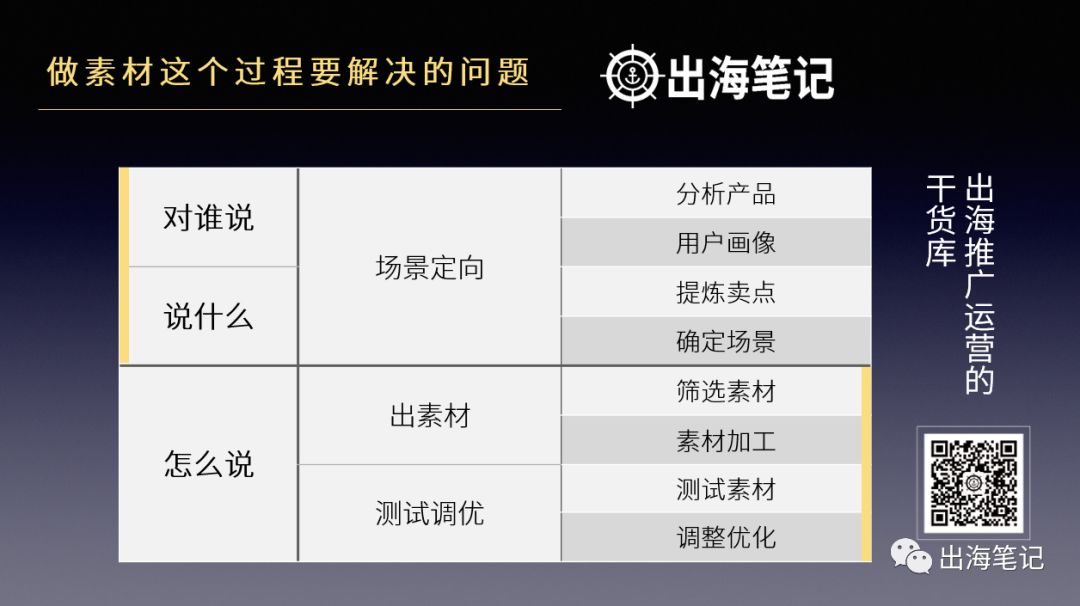
Also note: Is it feasible to expand low-quality advertising? (The captain has brought a lot of promoters in the past to complete KPIs often do this) of course. Can you maintain the effectiveness of your ads? It's unlikely. Facebook has a strong emphasis on the user experience, and as an advertiser you should never lose sight of it. Facebook introduced relevance scores in 2015 to rate ads in the ad auction segment. In 2018, Facebook added user feedback that allows Facebook users to score store purchases and after-sales experiences. These are all to improve the user experience, which will eventually lead to some accounts being de-rights or even blocked. 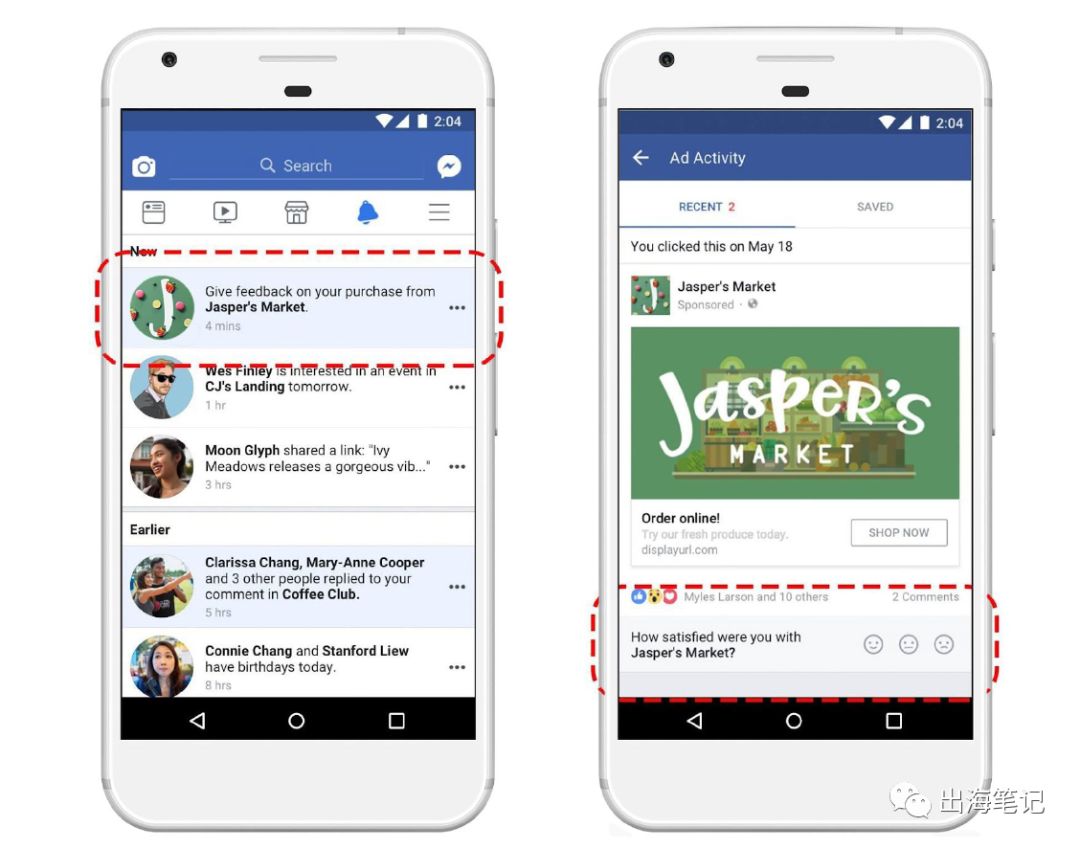
In this case, brand image and user experience are the core elements. We want the user's feelings to be:The product is cool, belongs, and can't be missed. These feelings can create a desire to buy and make them feel like they need your product。 (Isn't it familiar?) It's consistent with the principle behind the captain's previous sharing of "the secret behind Facebook's high-click-through material." Each time we start a new project, we first look at the target audience from a marketing perspective, study the market and competition, create the perfect customer image, and conduct multi-angle testing. There are a lot of ideas that need to be made when you think of the perfect customer in the early stages. We used the 5W model method to tap into the emotional needs of our customers, the usefulness of our products, and most importantly, the reasons why customers reject them. 5W model method WHAT What your product looks like (simple description) WHO Who are your (think) target audiences? WHY: Emotional factors (irrational) WHY: Practicality From an emotional point of view to arouse the customer's desire to buy. At this point, the customer will not think rationally, nor will they consider the price of the product. Features offered by the product, such as watches (fashionable, replaceable straps), free shipping, unconditional returns, refunds, and any benefits that are helpful to sales WHY NOT Why aren't customers enough to buy your products?/Service? List the causes and break them down item by item.
Take notes at sea
Select overseas promotion and operation of the first line of real-life dry goods
The official website www.chuhaibiji.com
Finding out why customers reject products and capturing their emotional needs are key to attracting customers.
(What a hero sees a little the same!) In fact, the captain's 5W3H tool to you to refine the scene than the great god's stronger, referenceThe Secrets Behind Facebook Ads' High Click-Through Material)
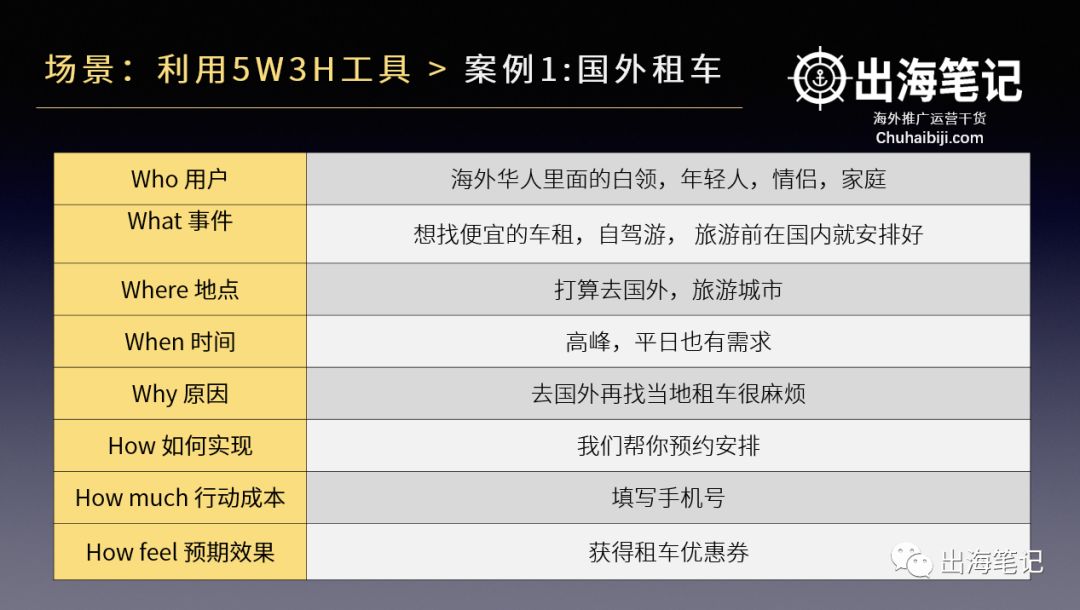
Through research and testing, we know that our customers value the skateboarding experience, and they love bright colors and stylish pictures. The next campaign revolves around that content.


Take notes at sea
Select overseas promotion and operation of the first line of real-life dry goods
The official website www.chuhaibiji.com


2 Fast small-scale testing

We want to create a creative store. In this process everything from Jane, focusing on three elements: brand, personality and scene. (It's the scene again) Cool, fun, engaging, it's the feeling that creativity has to bring. Of course, the brand's theme (ski equipment) should be clear, we use the product to reflect the use of the scene. (It's a case version of the article the captain shared earlier) This is our promotional test using the grading framework: The basic extension structure of the first phase: Find new customers for cold start-ups; Then market to customers who have visited the store but have not purchased the product; Design a campaign to test, and then set up another campaign to expand;
When this phase is complete, a new campaign is set up for people who have interacted with the account content but have not clicked, as well as existing customers (focusing on the customer's lifetime value). But in the early stages, the simpler the campaign, the better. The phased account structure that needs to be built for the entire promotion test is as follows: Cold Start: Find new customers Boost purchase intent (Warm Group): Interactions such as video views, Instagram/Facebook participants, emails, and more Promote Purchases (Hot Group): Re-marketing such as viewing website content, adding customers to shopping carts, etc Buy-in/retention (Existing group): Existing customers buy-to-buy, cross-sell
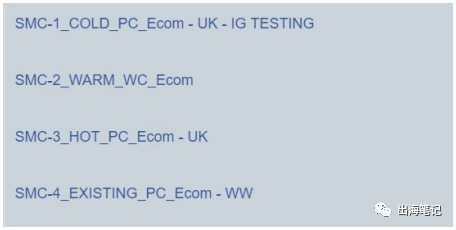
Based on our understanding of market trends and historical data from Facebook and Google Analytics, we have developed a promotion plan. We initially looked for new customers in nine core countries, with the goal of finding high-performing advertising groups to expand. We also disassembled dynamic (DPA) campaigns for de-marketing in the same way. 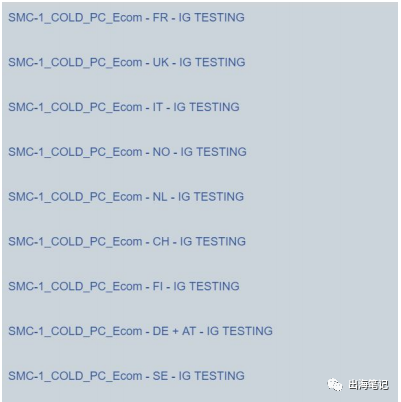
We first tested 12-16 sets of creatives for a 3-5 audience in one country. Once the ad impression reaches a certain value, we suspend the ad. For the stores we serve, the cost of adding a shopping cart (ATC) is most closely related to CPA/ROAS, so shopping cart ATC costs are our criteria for evaluating advertising performance. After initial testing, we reduced the number of 12-16 creatives to 6-8 to find the most popular materials in the 3-5 audience. With this 6-8 set of material, we tested different seed audiences: By interest Widespread promotion All potential audiences in the marketing funnel
In the initial test, 50-70% of the creatives matched a certain audience, but the same material did not necessarily match other audiences. If the footage matches your audience less than 50%, we'll look for other matching footage and make some changes. If it still doesn't match, it means the audience isn't right, and we'll abandon that audience. It's important that your audience needs a lot of information to take action, which is why we test a lot of variables in any ad group. By testing, we found that high-contrast close-up images bring the highest click-through rate of the front-end metrics. But don't mistake click-through rates (CTRs) for profitability and expansion. We have a lot of good ads with a click-through rate of only 0.8%-0.9%, which you may think is very low, but their ROAS can be as high as 10-20 times. At first, the focus of our testing was on reducing use"First checkout" (click directly on payment or put in cart to pay)tested up to 5,000 impressions of the creative. If you can sell a product, it's a good creative group that's doing well. Our thousand impressions cost (CPM) about $5, 5,000 shows so we can test each ad for $25. The $200 price per unit, 1-2 units sold for each test, suggests that the grading method we used worked from the start. The key to getting attention and getting users to take action is to use some techniques. For example, the use of face images lying to the user, bright high-contrast images, combined with existing videos and pictures, to find the best combination of ads. Don't pay too much attention to click-through rates, look for high-quality traffic downstream of the marketing funnel. We use the 3N advertising method. This approach comes from the AIDA marketing principles: Awareness, Interest, Desire, Action. (The captain's method AIDAS model is more advanced because there is an S, the model see.)"Case Review - Data Analysis, Diagnosis and Optimization of the Secrets of High ROI Advertising") 
(AIDAS model in the Sea Note Edition) With these four steps, customers can go through the process from knowing the brand to taking action. I've been using this method for years. To my surprise, many people do not yet know this method. 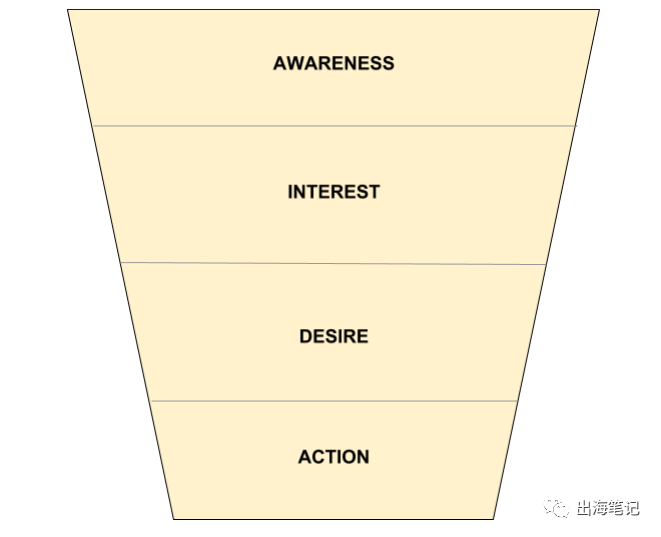
We want to achieve three things in an ad: Prevent users from skipping our ads Let users interact with ads (read, watch, get interested) Get people to take action (conversions)
The goal is to move the user from one stage to the next, 3 times in total. While I firmly believe that there should be a balance between advertising and creative materials, I'm sure strong visual material is far more important than photo. Here's one of our best-performing ads. We tried a lot of paper, there are short and long, or use a lot of paper templates, but none is better than the following version. Why? Because the text effect is not as important as the visual effect. The effect of this picture is more useful than writing 1000 words. This is the power of effect marketing under the leadership of brand promotion. However, bad paper work can make advertising different. "Buy now, discount up to 60%", such a document is not suitable for our stores. Many new shopkeepers use such a paper to do everything possible to increase ad click-through. However, the quality of clicks is far more important than the number. Low click-through rates can also lead to high conversion rates. 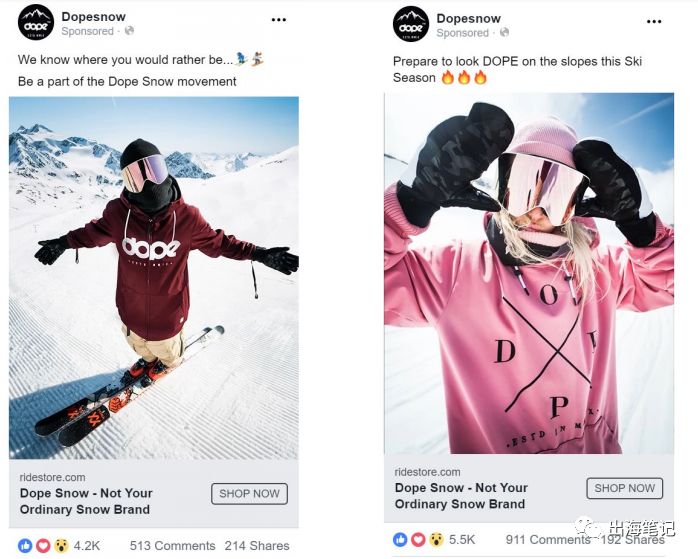
By grading tests, we focus on tests with higher output. The budget for each ad group is $50-$150 a day. Our goal is to test quickly and then expand. With up to 5,000 impressions, we can tell which ad is better based on sales. But in many cases, 2,000 impressions is enough for us to assess the success of an ad based on the cost of adding a shopping cart. We tested different materials (rotation, static, video, atlas) and pictures of various styles (one male, one female, two men, two women, one man and one woman, different costumes, colors, postures, etc.). With these quick tests, you can test many variables at low cost and then pick out the best ads to see if you can invest more in them. This approach applies in almost all cases. 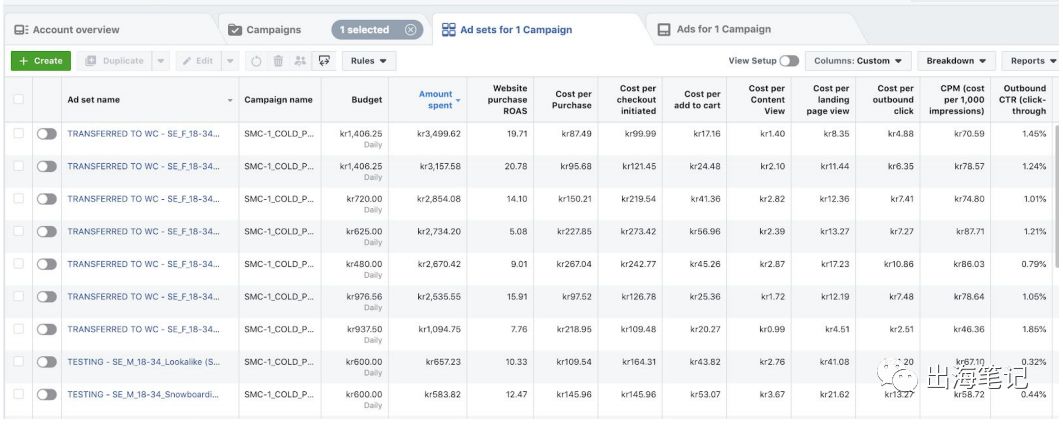
We started testing in September and hope to expand wildly during the peak periods of Christmas and the fourth quarter. At the time, stores were already able to make six figures a month, but we needed to quickly increase that number by 20 times! Ideally, going into September, it's taken months to test and find the right material and audience, so we don't recommend using our strategy until the fourth quarter. In our case, about 90% of the budget was spent on testing and 10% on re-marketing. Then we found the ad group that performed well in advance and started to expand, leaving about 20% of the test budget. The rest of the money is allocated to expansion and re-marketing.
Find new customers for cold start-ups; Then market to customers who have visited the store but have not purchased the product; Design a campaign to test, and then set up another campaign to expand;
Cold Start: Find new customers Boost purchase intent (Warm Group): Interactions such as video views, Instagram/Facebook participants, emails, and more Promote Purchases (Hot Group): Re-marketing such as viewing website content, adding customers to shopping carts, etc Buy-in/retention (Existing group): Existing customers buy-to-buy, cross-sell


By interest Widespread promotion All potential audiences in the marketing funnel


Prevent users from skipping our ads Let users interact with ads (read, watch, get interested) Get people to take action (conversions)



3 CPM low, ROAS maximum

In early 2018, Facebook made a major update, introducing the concept of "meaningful interaction" to assess post engagement. This means that posts that ask users to comment, or that Facebook considers low-quality posts, are punished to promote posts with high interactive quality (those posts have more than one word of comment and more replies). 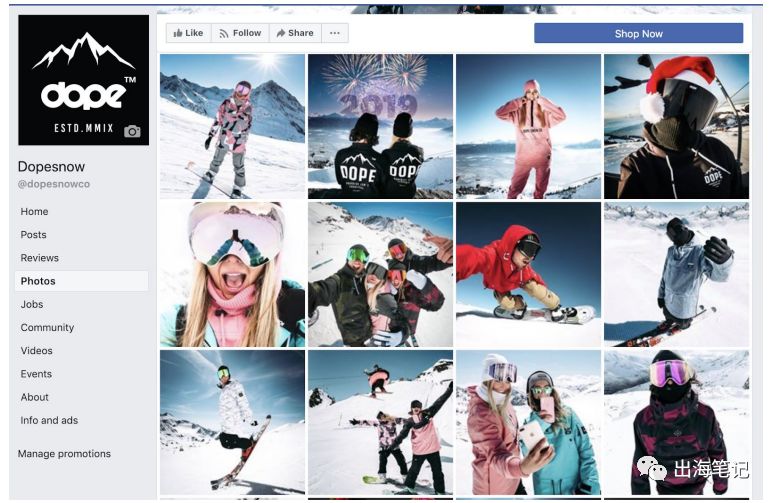
However, many people ignore the impact of Page engagement. It's common for some advertisers to create new Pages and run ads that are less relevant to the Page. In fact, the right thing to do is to do more to ensure the quality of your Page, share content regularly, and grow your fans in a regular way. In the past 12 months, those ads with high natural interaction rates have had lower CPM in the ad accounts we've worked with. While the use of advertising to promote premium content does not guarantee low CPM, this approach has been proven to bring in good revenue. In order to reduce CPM, we test whether Page posts can bring high engagement rate, optimize the Page, through advertising investment to further expand the reach of the Page. Don't just focus on likes, comments, and shares, and think about whether posts can improve the user experience with Facebook. 
Facebook is now more focused on high-quality interactions than just likes. In the example above, we tested three posts with the same advertising budget (about $100). As a result, it's clear that the posts in the middle are much more appealing, not just likes, but also comments. Because the post sparked the user's imagination, the combination of the text and the amazing video allowed the post to spread quickly.



4 Regular and maintain profit under the expansion

In the first quarter of 2018, we used a horizontal expansion technique (horizontal expansion on a higher budget: copy ad groups, segment age, gender, location, device, etc.). In the first quarter of 2018, however, Facebook changed the game. The algorithm begins to focus on the history and stability of the ad group. For example, an ad group that used to convert to a purpose needs 25-30 conversions a week, and now needs at least 50 conversions. We started this time with a vertical expansion (to increase the budget). Facebook's previous update was a 40 percent daily increase in its advertising budget, which had no impact on the learning phase. We have increased our budget by 30% according to the following rules: 
Set up Facebook delivery rules: Campaigns looking for new customers are at least five times more ROAS, and if the rules in the image above are met, they automatically expand by 25% at 7 a.m. each morning. Before expanding, we'll look at yesterday's ad performance and the last 3 days. We noticed that the frequency of ad appearance (frequency) was greater than 2 for 3 consecutive days, and the ad performance declined.
Previously, we tested high-quality conversion metrics like "join the shopping cart" or "initiate checkout", and the volume-extending test added purchase events to evaluate which ad worked best. It's better to often optimize the "initiate checkout" conversion goal for a $200 product, because the launch checkout and purchase are so close that you can find more high-quality audiences at a lower cost. Then sell the product through re-marketing. In our case, however, despite the high unit price, ROAS is the highest campaign for purchases. Our CPM is low, relevance score is high, website conversion rate is also 3-4%, with such a foundation, we can increase the expansion efforts. 
5 Geographical expansion with the goal of faster growth
While not all stores are able to expand their advertising in multiple locations, many may not take advantage of the opportunity to test new markets. In this case, we can open up markets in several countries (the owner has the ability to translate), and we are also testing the market in English and small European languages, which is our main goal in Europe. Testing in our strategy is a critical part of our strategy to understand which ads, materials, text and CTA can work in different markets. Cultural differences are a factor affecting marketing, people in different cultural backgrounds have different reactions to the same creative materials and text. So good advertising exports to other countries may fail, but don't think the market doesn't work. Some research should be done, especially to monitor the effectiveness of competitors' advertising in new markets. Our usual practice is to include important markets in different campaigns, test geographic differences, and test the effectiveness of ads written in local languages. 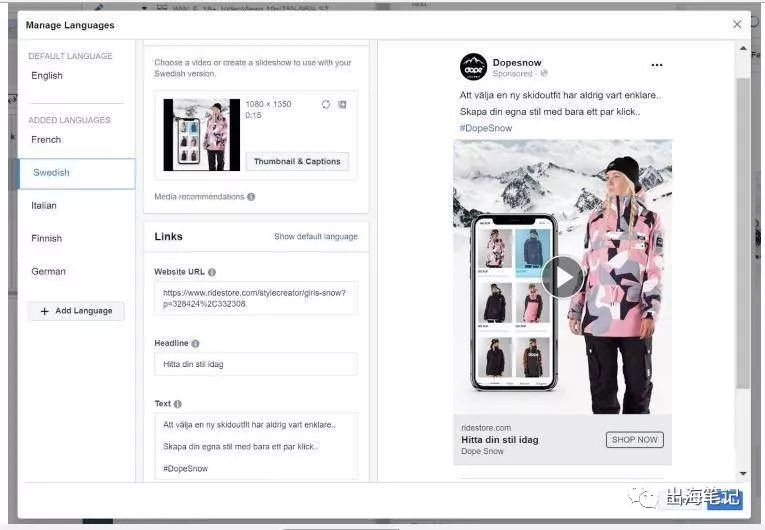
One way to help with amplification is to use dynamic language ads. Writing an ad in up to five languages is useful for de-marketing, although the disadvantage is that ads cannot be analyzed separately. But every optimization is important when expanding in 20-30 countries. Another suggestion is to market worldwide, sell products through home pages and find new customers in countries that might attract visitors.




6 Bring high ROAS creatives

By testing, we can ensure that the experience of other accounts is not introduced into new campaigns so as not to interfere with our judgment. Instead, we test our audience to see which ad typography and footage work best, and let the data make decisions for us. In our case, collection ads worked best, spending $153,000 in September alone. After testing the core elements and modifying the ad scheme, we used atlas ads alone to bring 8.6 times as much ROAS traffic to the cold start phase. 
The key to the success of carousel ads: 1. Format is very important The type and format of the footage has a significant impact on the performance of your ads. On Instagram, square images should be used at 1:1, while vertical images at 4:5 work better on Facebook. Sometimes intuition is more important Atlas ads can show a lot of staples at once. The 3 or 4 images you choose to display have a significant impact on CTR and may also have an impact on other metrics in the marketing funnel. So we naturally want to leave space for the best-selling products, right? Wrong. After countless tests, we found that front-end indicators (e.g. CTR) for high-contrast products were better, correlation scores were 1-2 points higher, shopping carts were simply lower, and ROAS was higher. Take a look at the advertisement above. The ad on the left shows a high-contrast product, the right is the best-selling product, which do you think is more attractive to your eye? 3. Advertising fatigue is real When expanding on a large scale, we need to rotate to use multiple sets of great material to prevent poor advertising performance. We'll add 8 materials to any scale promotion, 3 of which are active. As soon as the effect gets worse, change to another one. Doing so can make the material's life cycle much longer. You can even pause ads that are getting worse and re-run them after 2-3 weeks, when new targets appear in your audience and old ads are forgotten.


7 CBO optimization method

Facebook has introduced Campaign Budget Optimization (CBO). CBO is a really good feature, but the key depends on how you use it. Our findings are: 1. Testing the advertising stage, CBO is not very useful. CBO is not stable enough in allocating advertising investment. We can't unify our goals with the results of the CBO. 2. CBO does not solve all problems when running multiple ad groups. Or stability is not enough. 3. CBO cannot intervene artificially. In our case, we couldn't pause ads and groups that didn't work well. So, since the CBO is so unstable, how can we increase our investment by 5,000 to 10,000 a day while maintaining a stable effect? With CPM increasing in the fourth quarter, how do we keep ROAS high? 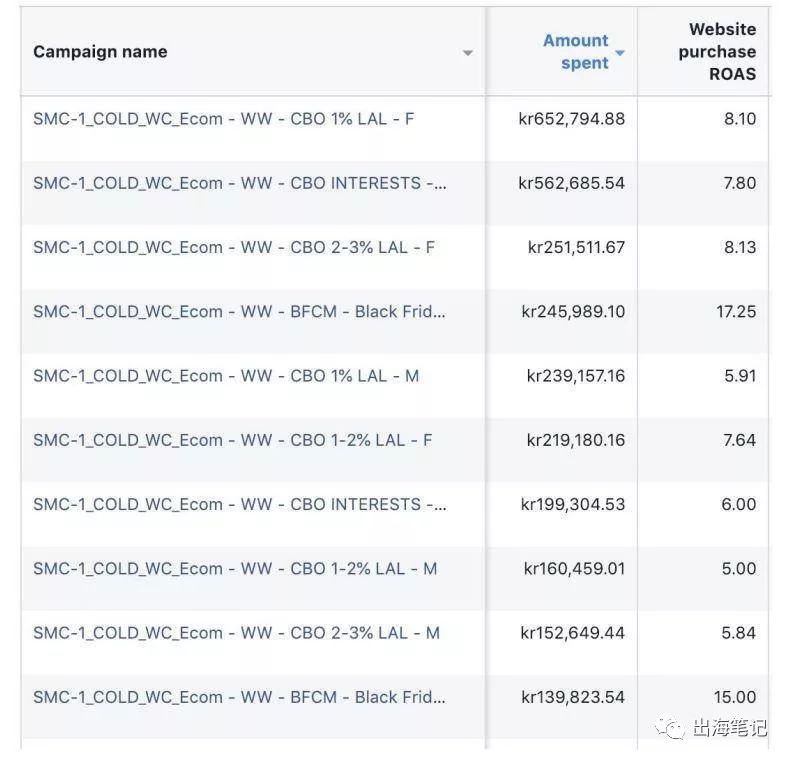
Here are our success companies that have been validated by several stores: 1. Use the rating test to find high-quality ad groups and ads 2. Expand the volume of high-quality advertising (groups) to ensure that the 'grade' successfully obtained 10 plus orders, and ROAS is very high 3. Budget optimization for premium advertising (groups) (CBO) These three steps are the core of CBO optimization. But the reality is much more complex: CBO works best when you group ad groups. In the image above, we put together similar audiences (1%, 1-2%) similar campaigns, and put interest-based and specific ad groups (such as "Black Five" ads) into different campaigns. Recently, we also used CBO to deal with remarketing campaigns with great success. We also found that one-day budget optimization was more stable than seven days. Our guess is that the budget is allocated between ad groups, and conversion rate data is collected at the campaign level, not just at the ad group level, so it doesn't take seven days of data. Therefore, "up-to-date" data is more important. This is true for items priced from $20 to $300 per unit. We used CBO to eliminate poor-performance ads and let Facebook allocate its budget to other ads. We've also added new ads to ad groups that don't have ads available. In general, an ad group will not run more than 3 ads, ad groups at least 5, up to 10, each invested 500 plus dollars. It's important to note that budgeting doesn't matter, because the rules remove ads that don't work well, leaving behind ads that work well. The higher the budget, the better the CBO will work. After the grading test, we added ad groups and ads to the normal campaign to see if we could expand in the traditional way, and then increase our budget and expand with CBO. You need to have enough budget for Facebook to add all ad groups and ad sorts to the auction. It takes a little time to know where it's best to invest. In addition, because bidding competition changes every day, the CBO can put the budget where it is right. If your ad doesn't work well, your budget won't be spent.
Take notes at sea
Select overseas promotion and operation of the first line of real-life dry goods
The official website www.chuhaibiji.com
Finally, choose the highest ROAS, or the lowest cost. 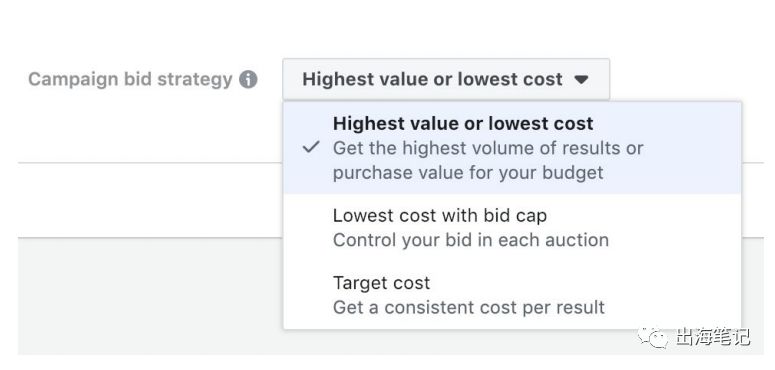
We believe that if you can design creative campaigns that maintain low CPM and high conversion rates, Facebook will give you the best users in the bidding process. If you make people happy, you're making Facebook cool. When marketing funnels aren't good enough, you can make manual bids, or if you think your ads and landing pages are better than Facebook thinks, you can skip Facebook's auto-bids and find a bigger audience. If you're sure your ads are good, manual bidding is good, but if they're bad, they're just burning money. Manual bids we've used many times in the past have greatly increased expenses and revenue. But now we prefer the CBO optimization method mentioned above.

Take notes at sea
Select overseas promotion and operation of the first line of real-life dry goods
The official website www.chuhaibiji.com


8 Black Five: Top traffic ROAS reaches 16 times

If the above trading is not good enough, what do you think of the Black Five 1600% ROAS? For every dollar of Facebook advertising, we get $16 in revenue, and we don't have the data to add to it. In order to achieve the greatest success in the Black Five, we did a lot of testing and made a lot of plans. 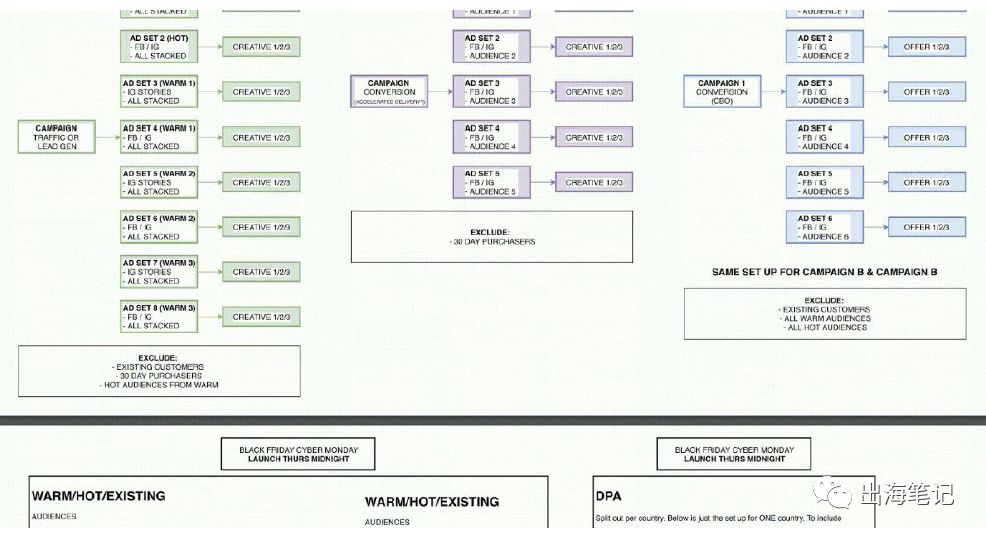
Detailed plans include scheduling test times, digging up marketing leads, and determining the structure of your campaign. We select custom customers (based on email, video viewing, interaction), website custom customers (based on web browsing). We also singled out 1-10% of lookalike audiences to test whether they could make money for stores, and then tested a larger percentage of lookalike audiences because it's much easier to reach more people on Facebook. Our initial goal was to find the best promotion in advance. So we did a series of A/B tests on existing customers, and we tested three ways to discount: A: Special sale area with discounts of up to x% B: Black five special limited products C: Specific bestsellers, discount x% 
At first, the results of Programme A and Programme C were similar, and Programme C was slightly better. We didn't fully trust the result and then waited a few more days. Then came a completely different situation. Option A has the lowest cost of adding a shopping cart ($0.35), the lowest CPA ($1.74), 100 per cent more sales than Option C and a staggering 87 times roAS. So it's important to wait a little longer for the test results, especially for stores with high unit prices. Because of the high unit price, customers think longer and attribution time. Deferred attribution has a significant impact on analysis and decision-making.



9 Thanksgiving: ROAS reaches 48 times

Based on past experience, we have come to two conclusions: Breaking codes is the worst thing about clothing Good products can always be quickly snapped up in the Black Five
Combined with these two points, we give customers the opportunity to buy our products privately before they go on sale, mainly through mail marketing, so that customers feel that they must not miss such a good opportunity. This method works on any holiday, such as Valentine's Day or Easter. 
That's what we do. Post the Black Five registration link 24 hours in advance Please net red for publicity Promote for a wide range of audiences Our goal is to maximize the reach. Time is very limited and it's important to cover all places. If we act too early, black five will slowly lose heat, so timing is important. Optimize your impressions to ensure that as many people as possible follow our activities
Using Facebook ads to collect potential customers' mailboxes is a cheap and important method for e-commerce sellers. Then by mail, customers have a desire to buy. At this point, mail is like a bridge connecting the customer's consciousness, interests, desires, and actions.
Breaking codes is the worst thing about clothing Good products can always be quickly snapped up in the Black Five

Post the Black Five registration link 24 hours in advance Please net red for publicity Promote for a wide range of audiences Our goal is to maximize the reach. Time is very limited and it's important to cover all places. If we act too early, black five will slowly lose heat, so timing is important. Optimize your impressions to ensure that as many people as possible follow our activities

10 Facebook is iterating, can you keep up?

Facebook is constantly adapting to external factors, and the eternal element of success is a focus on the user experience. Facebook rewards you for making people happy. This includes testing to find ads that match your audience, moving them from passive brand awareness to proactive action. Mastering the essence of Facebook's marketing is at the heart of a flood of successful ads. Managing orders and inventory is one of the biggest challenges in opening an online store, so dropshipping is so appealing. But if you can create a unique good product, you're in a blue sea and you're ahead of the competition. As Facebook continues to optimize and update, delivery skills change every few months, but our strategy is always "marketing principles first, platform skills second." (That's the "marketing thinking" that the captain emphasizes every time) The most interesting aspects of Facebook ads today are: Conduct extensive testing to find the ideal customer, use marketing techniques and mature materials and documents to persuade customers to buy products. Better, meaningful home page interactions lead to lower CPM. Organized testing and amplification to create repeatable and successful advertising to achieve the expansion goal. Experiment with your own products because there are few strategies for all stores. In short, products or services should be able to effectively solve problems or improve the quality of life of customers. What you need to do is figure out how to make customers want to buy, provide details, and simplify the buying process.
END
Conduct extensive testing to find the ideal customer, use marketing techniques and mature materials and documents to persuade customers to buy products. Better, meaningful home page interactions lead to lower CPM. Organized testing and amplification to create repeatable and successful advertising to achieve the expansion goal. Experiment with your own products because there are few strategies for all stores. In short, products or services should be able to effectively solve problems or improve the quality of life of customers. What you need to do is figure out how to make customers want to buy, provide details, and simplify the buying process.
The little editor patted you on the back
And please help her with someShare, Like and Look
Go to "Discovery" - "Take a look" browse "Friends are watching"